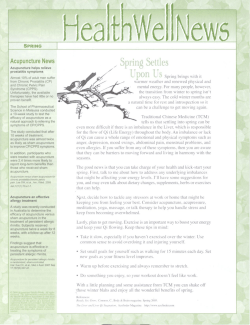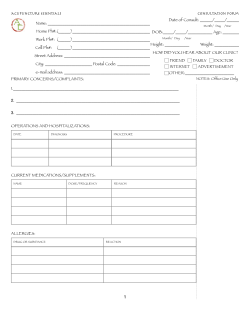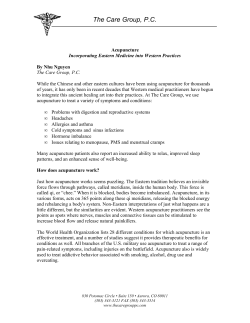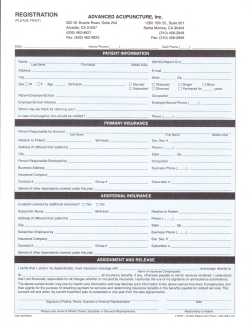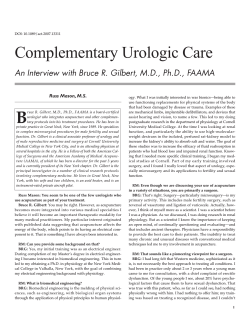
Acupuncture instead of codeine for tonsillectomy pain in children * §
International Journal of Pediatric Otorhinolaryngology 77 (2013) 2058–2062 Contents lists available at ScienceDirect International Journal of Pediatric Otorhinolaryngology journal homepage: www.elsevier.com/locate/ijporl Acupuncture instead of codeine for tonsillectomy pain in children§ James W. Ochi 1,2,3,* Children’s ENT of San Diego, Inc., 477 North El Camino Real, Suite C303, Encinitas, CA 92024, United States A R T I C L E I N F O A B S T R A C T Article history: Received 27 August 2013 Received in revised form 6 October 2013 Accepted 9 October 2013 Available online 20 October 2013 Objectives: Severe throat pain can result from tonsillectomy and last up to 10 days in children. Codeine elixir has long been used for pain relief, but has recently been banned by the Food and Drug Administration due to a recently recognized risk of death. We explored acupuncture as an alternative means of pain relief for children and adolescents after tonsillectomy. Methods: This was a retrospective review of children and adolescents who underwent tonsillectomy over a three-month period. No narcotics were prescribed after surgery. Patients who wanted help with pain relief were offered acupuncture. Perceived pain level was assessed before and after the acupuncture treatment. Following the 10-day recovery for tonsillectomy, patients or their parents were queried as to how long the pain relief from acupuncture intervention was perceived to last. Results: 56 children and adolescents underwent tonsillectomy in the three-month window selected for the retrospective review. 31 of these patients (ranging from 2 to 17 years in age) received an acupuncture intervention for postoperative pain. The mean reported pain level before acupuncture was 5.52 (SD = 2.28) out of 10. This fell to 1.92 (SD = 2.43) after acupuncture. Statistical analysis supported the general conclusion that pain reports decline after acupuncture in the sampled population. However, the limitations of the methodology and the sample suggest that this generalization should be treated as preliminary. 17 patients or their parents provided a post-recovery report for how long they believed the acupuncture intervention lasted. The mean duration of perceived acupuncture benefit was 61.24 h, though the standard deviation was large (64.58 h) with about 30% of patients reporting less than three hours of benefit and about 30% reporting more than 60 h. No adverse effects were observed as a result of acupuncture treatments. Conclusions: The data tentatively suggest that acupuncture decreases perceived pain in children and adolescents after tonsillectomy. These data – combined with the cost effectiveness, safety and ease of administering acupuncture – suggest that further studies exploring the effectiveness of acupuncture in juveniles after tonsillectomy are merited. ß 2013 The Author. Published by Elsevier Ireland Ltd. All rights reserved. Keywords: Tonsillectomy Pain Children Acupuncture Codeine 1. Background Tonsillectomy is a uniform surgical insult which results in a predictable course of healing and decreasing pain over about 10 days [1]. More than a half million tonsillectomies are done annually in the United States [2]. This surgery often results in severe throat pain which can last throughout and beyond the § This is an open-access article distributed under the terms of the Creative Commons Attribution-NonCommercial-No Derivative Works License, which permits non-commercial use, distribution, and reproduction in any medium, provided the original author and source are credited. * Tel.: +1 858 792 4800; fax: +1 858 259 6286. E-mail address: jochi@integrativeENT.com 1 Rady Children’s Hospital, San Diego, CA, United States. 2 El Centro Regional Medical Center, El Centro, CA, United States. 3 UC San Diego School of Medicine, San Diego, CA, United States. standard 10-day recovery period [3]. There have been two major approaches to reducing this post-operative pain. First, efforts are made to reduce tissue trauma during surgery. Various technology-assisted surgical instruments have been developed to reduce tissue damage. All of these devices increase the cost of tonsillectomy but no surgical instrument or technique has been found to be superior to the rest at decreasing pain [4–7]. Intravenous medications such as ondansetron and dexamethasone are helpful in reducing postoperative nausea and pain and are routinely given during surgery [8]. Second, pain medication is prescribed to relieve pain after surgery. For decades doctors have prescribed codeine elixir. However, about 7% of the general population metabolizes codeine in an ultra-rapid fashion to morphine [9], the active metabolite. This can lead to morphine levels which far exceed therapeutic levels [10] and, on rare occasions, result in death from respiratory arrest. In February 2013 the Food and Drug Administration issued a Boxed Warning [11], the agency’s strongest warning, banning the 0165-5876/$ – see front matter ß 2013 The Author. Published by Elsevier Ireland Ltd. All rights reserved. http://dx.doi.org/10.1016/j.ijporl.2013.10.008 J.W. Ochi / International Journal of Pediatric Otorhinolaryngology 77 (2013) 2058–2062 use of codeine after pediatric tonsillectomy. Some doctors prescribe hydrocodone elixir in place of codeine elixir for their patients. However, hydrocodone elixir is metabolized in the same manner as codeine and thus also exposes patients to the risk of respiratory arrest [12]. The current study came about as a result of the author’s search for a safe and effective substitute for codeine. I explore in this report the use of acupuncture as an alternative to narcotics to reduce post-operative tonsillectomy pain in juveniles (children and adolescents). Acupuncture in general has been shown to reduce pain [13], has a low risk of complications [14], can be done quickly, and has minimal cost. However, its employment in support of surgical interventions remains a novel practice in Western medicine. Nonetheless, its application is increasing. A recent Boston Children’s Hospital study showed patients having acupuncture at anesthetic induction prior to undergoing tympanostomy tube placement experienced less post-operative pain and emergence agitation than controls after surgery [15]. This result encouraged me to move beyond the scope of the Boston study to determine whether acupuncture would be effective in relieving pain in patients on whom I performed tonsillectomies – a surgery requiring a much more protracted recovery. Tympanostomy tube patients almost always attend school the next day. In contrast, tonsillectomy patients can miss school for up to 10 days. The following analysis is a formal exploration of the perceived pain relief by those tonsillectomy patients who accepted postoperative acupuncture. 2. Methods 2.1. Participants The author performed all surgeries and acupuncture techniques. All surgeries were done at Rady Children’s Hospital in San Diego; acupuncture was done at El Centro Regional Medical Center Outpatient Clinic in El Centro, CA and an office in Encinitas, CA. The study is a retrospective review of juvenile tonsillectomy patients. The patient pool was drawn from the author’s practice and included all patients less than 18 years of age who underwent tonsillectomy during a 3-month period beginning January 15, 2013 and ending April 16, 2013. The Institutional Review Board of Rady Children’s Hospital granted approval for this retrospective chart review. 56 juvenile patients underwent tonsillectomy during the 3month study period. In addition: all 56 patients also had adenoidectomy; 13 had bilateral myringotomy and tube insertion; two had nasal cautery; and one had cerumen removal. There were no intra-operative complications. However, one patient experienced oropharyngeal bleeding 11 days postoperatively which required cauterization under anesthesia. Not all 56 patients were considered in the current review. Selected patients had to meet the following two criteria. First, they had to present for pain relief within the traditional 10-day tonsillectomy recovery window. Second, selected patients had to [(Fig._1)TD$IG]receive the acupuncture intervention. This was purely a pragmatic 2059 constraint due to study limitations: only patients who received the intervention were assessed for pain relief. No pain data was available for patients who received no treatment. 42 patients presented during the first 10 days after surgery for pain relief. Nine of these patients refused acupuncture. Patients who declined acupuncture were offered an acupressure intervention instead. At that point, they ceased to be regarded as participants and were excluded from the study sample. The remaining two rated their pain score as 0 and were not offered acupuncture. The final study sample consisted of 31 patients (20 females, 11 males) who agreed to undergo an acupuncture intervention. The mean age of this sample was 9.23 years (SD = 4.32 years, range = 2– 17 years). Pain reports were collected from these patients or their parents immediately before and after the intervention. 17 of these patients or parents (10 females, 7 males) provided an additional report after the recovery window, estimating how long the benefits of the acupuncture intervention lasted. The mean age of this subsample was 9.59 years (SD = 4.05 years, range = 5–16 years). 2.2. Tonsillectomy Patients received a total of 2–3 cc of 1% lidocaine with 1:100,000 epinephrine injected into both tonsil beds before the start of surgery. An anesthetic technique using nitrous oxide and sevoflurane was used for all patients. Tonsillectomy was done using monopolar electrocautery set at 24 W and all patients were given intravenous dexamethasone 0.5 mg/kg up to a maximum of 12 mg. None of the patients were prescribed narcotics for use at home. Parents were advised to use acetaminophen or ibuprofen elixir for pain relief. Patients were allowed to return to normal activity at their own discretion and no dietary restrictions were suggested. 2.3. Acupuncture intervention and pain reports Patients were invited to return during the 10-day recovery if the family wanted help with pain relief. Upon arrival, the patient or parent (pending patient age and apparent maturity) was asked to use the Faces Pain Score-Revised Scale (Fig. 1) to assess current level of discomfort. If the pain score was greater than zero, acupuncture was offered free of charge for the patient. This measurement was repeated again immediately after the acupuncture treatment resulting in a ‘‘before acupuncture’’ pain report and an ‘‘after acupuncture’’ pain report. The acupuncture intervention used sterile, single-use, stainless steel acupuncture needles with a shaft of 15 mm in length and 0.16 mm in diameter [16] and a shaft of 40 mm in length and 0.25 mm in diameter [17] (Seirin, Shizuoka, Japan). The acupuncture point LI4 (Fig. 2) was the primary point chosen for use in the acupuncture intervention. This point has been shown effective in randomized, controlled trials at reducing pain after aural [15] and oral surgery [18,19]. Stimulation at LI4 increases activity in the somatosensory cortex and a region of the brainstem known as the periaqueductal gray area, as revealed by functional magnetic resonance imaging, that are involved in processing pain Fig. 1. FACES Pain Score-Revised Scale. [(Fig._2)TD$IG] J.W. Ochi / International Journal of Pediatric Otorhinolaryngology 77 (2013) 2058–2062 2060 Fig. 2. Acupuncture points. All patients received acupuncture at LI4. Patients received acupuncture bilaterally at LI20, LI11, LI10 and LI4. signals [20]. The reported benefits of L14 stimulation is reinforced by the author’s own personal clinical acupuncture experience. Prior to the current study, the author observed significant tonsillectomy pain relief from patients using only the L14 acupuncture point. All acupuncture recipients in this current study received treatment at LI4. Feedback from older patients – again, prior to the current study – suggested that additional points were effective in relieving tonsillectomy pain, particularly CV23, GV24.5 and GV20. These and other points were applied on as-needed basis, following standard clinical acupuncture practice. The full range of points (with one exception) used in the current study and the frequency they were employed is described in Table 1. The exception: one patient had an Ah Shi point (area of tenderness not located at a recognized acupuncture point) in the midline along the upper sternum needled. The mean duration of acupuncture treatment was 16.1 min (SD = 9.6 min; range = 3–39 min). There were no complications or adverse events from the acupuncture interventions. 2.3.1. Measuring the duration of acupuncture benefits Patients who had acupuncture were asked to return after the 10-day recovery period and the patient or parents were queried as to how long (in hours, days or weeks) the acupuncture treatment was of benefit. This time estimate was converted to hours if needed and recorded. level was 3.60 (SD = 2.44). The individual and mean trends in reported pain level are displayed in Fig. 3. 3.1. Preliminary analyses Prior to conducting the primary statistical analysis, participant age, acupuncture duration, and the number of days between surgery and acupuncture intervention were explored as possible confounding factors. Each of these could reasonably have influenced pain report as measured in the current design. There were no statistically significant correlations or other observable associations between these factors and any changes in pain reports. These current results – though statistically inconclusive and based on a limited research design – at the very least did not support the hypothesis that these factors were influencing the change reports. These factors were excluded from further analysis in the current report. [(Fig._3)TD$IG] 3. Results As noted, there were 31 total patients who received the acupuncture intervention. The mean reported pain level before acupuncture was 5.52 (SD = 2.28) out of 10. This fell to 1.92 (SD = 2.43) after acupuncture. The average change in reported pain Table 1 Frequency of acupuncture points. LI4, LI20, LI11 and LI10 are bilateral points but for the purposes of this table are only counted once for each patient. This study involved 31 children who had acupuncture for postoperative tonsillectomy pain. Acupuncture point Treatments using point LI4 CV23 GV24.5 GV20 LI20 LI11 LI10 31 17 12 6 2 1 1 Fig. 3. Pain scores before and after acupuncture. Individual pain score trends with the mean pain score trend overlaid in bold for 31 patients. There appear to be fewer lines than patients because some individuals had identical starting and ending pain report values. J.W. Ochi / International Journal of Pediatric Otorhinolaryngology 77 (2013) 2058–2062 3.2. Primary analyses Changes in pain reports were examined using a dependent samples t-test and reached statistical significance, t(30) = 8.19, p < 0.01. Statistical significance suggests that our current sample is unlikely to be observed under the null hypothesis and can be taken as evidence that trends observed in the sample are likely to generalize to the sample population. Given the exploratory nature of the study, some estimate of the magnitude of the effect of the acupuncture treatment on pain reports is perhaps of greater interest. Three estimates were selected. The first selection was the confidence interval for the mean change in pain report: 95% CI [ 4.49, 2.70]. The second selection was a standard measure of effect size for a dependent samples t-test: r2 = 0.69. Both estimates suggest that, at least based on the available sample, acupuncture has a non-negligible effect on pain reports. Finally, the breakdown of pain score differences was examined directly: no patients reported an increase in pain scores, only 3 of 31 (9.68%) reported no change, 27 of 31 (87.10%) reported at least two units of pain reduction, and 18 of 31 (58.06%) reported at least three units of pain reduction. Finally, the 17 estimates of acupuncture benefit duration were examined. All patient estimates were converted to hours and ‘‘capped’’ by the tonsillectomy recovery window. Put another way, if a patient on day nine claimed that acupuncture lasted for 62 h (three days), this estimate was restricted to 48 h (the full day nine and the full day 10). Estimates were capped in this manner to minimize the extent to which patients conflated acupuncture pain relief with the pain relief accompanying the natural healing process, which should produce a minimum pain around or shortly after day 10 for most patients. The mean estimated duration of acupuncture benefit was 61.24 h (SD = 64.58 h, range = 1–168 h). Five of 17 patients (29.41%) reported less than three hours of benefit, five (29.41%) reported more than 60 h, and the remaining seven patients (41.18%) reported intermediate durations. 4. Discussion The data from this retrospective chart review suggests that acupuncture after tonsillectomy is associated with decreased pain in children and adolescents. Furthermore, estimates of effect size and effect duration suggest that the magnitude of this effect may be large enough – and typically last long enough – to make the intervention worthwhile. The phrasing of the above statements, however, is important: the current results should be treated as suggestive. Though the trends are promising and – at least to the author – exciting, the reader is urged to bear in mind the study limitations. The study sample was a sample of convenience. The current design employed neither random assignment nor control conditions against which to compare the acupuncture procedure. The experimenter and participants were not blind and both were motivated to see pain reduced. There was variability in participant age, reporting, and the specifics of the acupuncture intervention. There are many points at which the current data could have been biased and future work will be necessary to confirm that acupuncture is as effective as it appears here. That future work however seems merited. Narcotics have long been the mainstay of therapy for children suffering pain after tonsillectomy. Since it is no longer safe to prescribe opioids, it is important to find other ways to help these children and acupuncture looks like a promising alternative. In addition to the current data and the growing body of studies exploring the efficacy of acupuncture, acupuncture compares very favorably in cost to new technology-assisted surgical instruments developed to reduce tissue trauma and subsequent pain. For 2061 example, the harmonic scalpel [21] and coblator [22] increase the cost by about $150.00 per patient but do not result in less pain [7]. In comparison, each of the acupuncture needles used in this study cost about 11 cents. Acupuncture in the hands of a well-trained practitioner is very safe with a risk profile comparable to prescribing penicillin [23]. Most states allow allopathic and osteopathic physicians to practice acupuncture under the authority of their medical licenses. Physicians who are interested in medical acupuncture can seek courses endorsed by the American Academy of Medical Acupuncture [24]. One concern raised about the utility of acupuncture – especially with young patients such as examined here – is that patients will reject the treatment. However, the author found children as young as two years of age agreeable to acupuncture. Another study showed that a set of hospitalized infants from nine days to nine months of age tolerated acupuncture well [25]. It is important to note that children (and adults) who decline acupuncture will often tolerate and benefit from acupressure performed at the acupuncture points we used. Indeed, those children who received acupressure in the current study also showed a mean decline in pain reports (not examined closely given the small sample size). Acupressure can be repeated at will and like acupuncture does not have associated adverse side effects found commonly with narcotics such as nausea, vomiting and constipation. Our study was limited to children but many adults also undergo tonsillectomy and often endure pain for a much longer time postoperatively. The recovery period is about 10 days in children. However, over half of adults in one study had pain up to 3 weeks postoperatively [26], suggesting that they are also viable candidates for possible acupuncture pain relief intervention. 5. Conclusions The data tentatively suggest that acupuncture decreases perceived pain in children and adolescents after tonsillectomy. Though randomized, controlled research needs to be done to confirm the trends observed in the current study, the combination of these preliminary results with the low cost and safety of acupuncture make it a promising way to relieve tonsillectomy pain in children and adolescents. Conflict of interest The author declares he has no competing interests. Sources of funding The author paid for all expenses related to this study. Author’s contributions JWO performed all surgical and acupuncture techniques. He conceived, designed and executed the study and wrote the manuscript. Acknowledgements The author is very grateful for the time and expertise contributed by Brian Waismeyer MA and Fraser Cocks PhD to this study. References [1] G. Isaacson, Tonsillectomy healing, Ann. Otol. Rhinol. Laryngol. 121 (2012) 645– 649. 2062 J.W. Ochi / International Journal of Pediatric Otorhinolaryngology 77 (2013) 2058–2062 [2] K.A. Cullen, M.J. Hall, A. Golosinskiy, Ambulatory surgery in the United States, Natl. Health Stat. Rep. 11 (2009) 1–28. [3] D.W. Stewart, P.G. Ragg, S. Sheppard, G.A. Chalkiadis, The severity and duration of postoperative pain and analgesia requirements in children after tonsillectomy, orchidopexy, or inguinal hernia repair, Paediatr. Anaesth. 22 (2012) 136–143. [4] V.G. Alexiou, M.S. Salazar-Salvia, P.N. Jervis, M.E. Falagas, Modern technologyassisted vs conventional tonsillectomy: a meta-analysis of randomized controlled trials, Arch. Otolaryngol. Head Neck Surg. 137 (2011) 558–570. [5] D. Parker, L. Howe, V. Unsworth, R. Hilliam, A randomised controlled trial to compare postoperative pain in children undergoing tonsillectomy using cold steel dissection with bipolar haemostasis versus coblation technique, Clin. Otolaryngol. 34 (2009) 225–231. [6] D.K. Pinder, H. Wilson, M.P. Hilton, Dissection versus diathermy for tonsillectomy, CDS Rev. 16 (2011) CD002211. [7] K.P. Oomen, V.K. Modi, M.G. Stewart, Evidence-based practice: pediatric tonsillectomy, Otolaryngol. Clin. North Am. 45 (2012) 1071–1081. [8] M. Allford, V. Guruswamy, A national survey of the anesthetic management of tonsillectomy surgery in children, Paediatr. Anaesth. 19 (2009) 145–152. [9] L.E. Kelly, M. Rieder, J. van den Anker, B. Malkin, C. Ross, M.N. Neely, et al., More codeine fatalities after tonsillectomy in North American children, Pediatrics 129 (2012) 1343–1347. [10] C. Ciskkowski, P. Madadi, M.S. Philips, A.E. Lauwers, G. Koren, Codeine, ultrarapidmetabolism genotype, and postoperative death, N. Engl. J. Med. 361 (2009) 827– 828. [11] U.S. Food and Drug Administration. [http://www.fda.gov/Drugs/DrugSafety/ ucm339112.htm]. [12] S. Sadhasivam, Myer CM 3rd: preventing opioid-related deaths in children undergoing surgery, Pain Med. 13 (2012) 982–983. [13] National Center for Complementary and Alternative Medicine. [http://nccam. nih.gov/health/acupuncture/acupuncture-for-pain.htm]. [14] K.J. Kemper, R. Sarah, E. Silver-Highfield, E. Xiarhos, L. Barnes, C. Berde, On pins and needles? Pediatric pain patients’ experience with acupuncture, Pediatrics 105 (2000) 941–947. [15] Y.C. Lin, R.F. Tassone, S. Jahng, R. Rahbar, R.S. Holzman, D. Zurakowski, et al., Acupuncture management of pain and emergence agitation in children after bilateral myringotomy and tympanostomy tube insertion, Paediatr. Anaesth. 19 (2009) 1096–1101. [16] Seirin J-15 Acupuncure Needles. [http://www.seirinamerica.com/j15.html]. [17] Seirin Laser L-Type Needles. [http://www.seirinamerica.com/ltype.html]. [18] L.L. Lao, S. Bergman, G.R. Hamilton, P. Langenberg, B. Berman, Evaluation of acupuncture for pain control after oral surgery: a Placebo-Controlled trial, Arch. Otolaryngol. Head Neck Surg. 125 (1999) 567–572. [19] K.S. Kim, K.N. Kim, K.G. Hwang, C.J. Park, Capsicum plaster at the Hegu point reduces postoperative analgesic requirement after orthognathic surgery, Anesth. Analg. 108 (2009) 992–996. [20] W.C. Liu, S.C. Feldman, D.B. Cook, D.L. Hung, T. Xu, A.J. Kalnin, Komisaruk BR: fMRI study of acupuncture-induced periaqueductal gray activity in humans, Neuroreport 15 (2004) 1937–1940. [21] Ethicon Endo-Surgery. [http://www.ees.com/Clinician/Specialty/ent/tonsillectomy#Overview]. [22] ArthroCare ENT. [http://www.arthrocareent.com/procedures/view/1-tonsillectomy]. [23] V. Jindal, A. Ge, P.J. Mansky, Safety and efficacy of acupuncture in children: a review of the evidence, J. Pediatr. Hematol. Oncol. 30 (2008) 431–442. [24] American Academy of Medical Acupuncture. [http://www.medicalacupuncture.org/Home.aspx]. [25] K.R. Gentry, K.L. McGinn, A. Kundu, A.M. Lynn, Acupuncture therapy for infants: a preliminary report on reasons for consultation, feasibility, and tolerability, Paediatr. Anaesth. 22 (2012) 690–695. [26] A. Salonen, H. Kokki, J. Nuutinen, Recovery after tonsillectomy in adults: a threeweek follow-up study, Laryngoscope 112 (2002) 94–98. Dr. James Ochi is a fellowship-trained pediatric otolaryngologist board-certified in both Otolaryngology and Medical Acupuncture. He is a Voluntary Assistant Clinical Professor of Surgery at UC San Diego School of Medicine in San Diego, CA.
© Copyright 2025
